By Stephen Enzweiler
Special to the Tribune
This is the second part of a five-part series on the 150th anniversary of St. Augustine Parish in Covington.
As the sun sets and night descends upon the residents of Peaselburg in central Covington, floodlights turn on and illuminate the façade and bell tower of St. Augustine Church. The joyous sound of its bells, silent for three months last year, is once more ringing for the people after months of restoration. Mass is said in the school gymnasium presently, as the task of the long-awaited and much-needed renovation of the main church interior enters its final months. Workers still squirrel about on the scaffolding and busy themselves like a hive of bees removing panels, re-plastering walls, replacing fixtures, and repainting ceilings, all in preparation to celebrate the 150th anniversary of St. Augustine parish this summer.
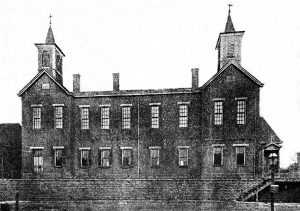
The original St. Augustine Church, 1870-1914. (Courtesy of the Kenton County Public Library, Covington.)
But the St. Augustine church we see today wasn’t the first Catholic church in Peaselburg to bear the name. The original parish church was built in 1870 to serve the early immigrant residents of the area. Its construction happened during a period of church building in Northern Kentucky brought about by tremendous population growth. But the story of the first St. Augustine church turned out to be much like the story of the saint himself after whom it was named. It is not only a story of misfortune and broken dreams, it is also a story of grace and redemption.
The first settlers came to the Peaselburg area in the early to mid-1800s. They were mainly German Catholics along with a smaller number of Irish families who fled the old country seeking a new life of freedom and opportunity in America. Peaselburg was originally a rural landscape of fertile farm fields, tangled thickets, woods, footpaths and dirt roads crisscrossing the valley. There was only a smattering of houses then, inhabited by German families with names like Hülsman, Toebbe, Göbbels, Staggenborg, and Hartlaub.
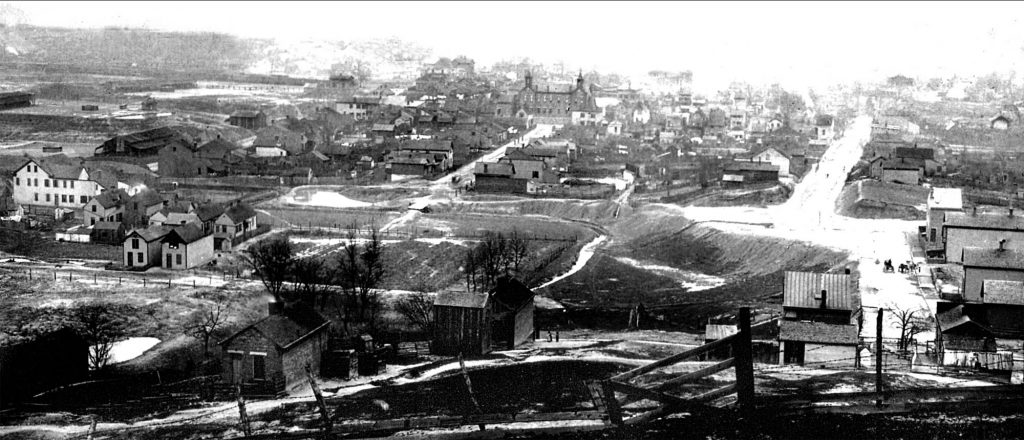
Birdseye view of Peaselburg taken from the Monte Cassino Monastery (view looking east). St. Augustine Church appears in the top center of the photograph. (Courtesy of the Kenton County Public Library, Covington.)
Up to this time, Peaselburg’s German families were forced to travel into Covington if they wished to attend Sunday mass in their own language or have their children educated in one of the German parish schools. There were four German churches then: Mother of God (1841); St. Joseph (1853); St. John (1854); and St. Aloyisius (1865), all of which were clustered near downtown Covington. Finally, as early as the 1860’s the need for a fifth German church to serve the rural populations of south Covington was identified.
After the Civil War, Peaselburg’s increasing population had transformed the valley from a smattering of houses to the status of a village. In 1869, Peaselburg’s German Catholic leaders finally petitioned the Most Reverend Augustus Maria Toebbe, second Bishop of Covington, to establish a parish church and school in their community. Bishop Toebbe, like many bishops across the country at the time, believed it was necessary to establish parishes for each immigrant group to accommodate their unique cultural, social and religious needs. The following spring, construction began on a combination church and school situated on a piece of property on the eastern side of what was then Holman Street at its intersection with Howard Street. On June 20, 1870, Bishop Toebbe laid the cornerstone, naming the new congregation “Saint Augustine” after his patron saint.
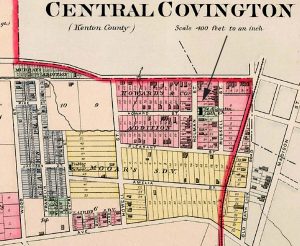
An 1883 Sanborn map of Peaselburg showing the location of the original St. Augustine Church (indicated by arrow). It was located on the eastern side of what was then Holman Street at its intersection with Howard Street. Holman St. south of Nineteenth was eventually closed and turned into housing while Howard St. became present-day Twentieth St. (Courtesy of the Kenton County Public Library, Covington.)
Designed more for functionality than for looks, it was a two-story brick structure that housed a church on the ground floor and a school upstairs, staffed by the Sisters of Notre Dame. The building itself was symmetrical in concept, with bell towers on both ends of the building and pitched roofs with crosses that could be seen for miles. The church interior had a low, undecorated ceiling and a sanctuary filled with a main altar, small side altars, statuary, a large mission cross, baptismal font, and chancel rail. In the nave were 83 pews to seat about 150 people, with seat space “rented” to families for $14 a year. Hanging incandescent lamps provided illumination and a wood-burning stove heated the interior in winter.
By autumn, construction was complete, and on October 16, 1870, Bishop Toebbe dedicated the church, appointing Rev. L. Neumeier as its first pastor. He was replaced four months later by an aging, thick-accented German-born priest named Rev. Joseph R. Goebbels. Fr. Goebbels quickly went to work, establishing several business opportunities to help enhance the property in the hopes these efforts might prove to be a financial boon and bring the parish self-sufficiency. In 1872, he bought property along the Kentucky Central Railroad tracks on which he started a brick manufacturing operation with two brickyards. Shortly after, he bought a nail-making machine from Germany, and along with parishioner Barney Melbers, started the “American Wire and Screw Nail Company,” one of the first of its kind in the United States. The businesses quickly began turning a profit, but the timing of the well-intentioned pastor couldn’t have been worse.
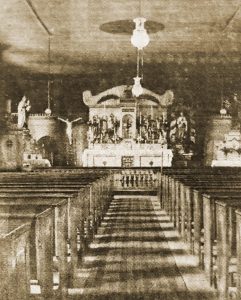
The only known photo of the interior of the old St. Augustine Church, taken by Joseph Dressman of Erlanger in 1905. (Courtesy of St. Augustine Church Archives.)
Only a year after establishing the two businesses, the Panic of 1873 swept the nation. It was a period of economic depression that caused massive bank and business failures across the country. Fr. Goebbels kept the brickyard and the wire and screw company operating in an attempt to stave off the effects of the economic downturn. Profits from the two companies were intended to pay off the debt and fund construction of a new church and school, but in the end, the economic conditions caused their failure. Fr. Goebbels was devastated. Many parishioners, including the pastor himself, lost the savings they had invested in the parish’s businesses. Creditors eventually filed suit, and after lengthy litigation, a court declared the parish bankrupt and ordered its properties and assets put up for sale to satisfy the creditors.
For several years, St. Augustine church and school languished. In 1875, Fr. Goebbels stepped down as pastor and was replaced by Fr. Clement Jesse, who died two years later from ill-health. In March 1877, Fr. Goebbels left the parish entirely and Bishop Toebbe appointed Rev. William Robbers to take the helm. Fr. Robbers, along with the parish Board of Trustees, organized a new corporation known as the “Roman Catholic German Church of Central Covington, Kentucky,” which immediately repurchased the building and associated properties that had been lost. As the years passed and the economic depression subsided, St. Augustine’s situation improved enough that Fr. Robbers was able to start saving money again. Yet things were about to improve even more when, in 1883, Bishop Toebbe appointed Rev. Paul T. Abeln to replace Fr. Robbers as pastor.
Father Abeln turned out to be the perfect choice to lead St. Augustine parish. He was tidy, ordered, industrious, with an eye for detail and a gift for organization. Born Paulus T. Abeln on October 1, 1843, in Neubörger, Lower Saxony, he immigrated to America on the ship Germany on July 9, 1871, and settled in Covington. Perhaps seeing a need among the growing German parishes of the diocese, he expressed his wish to become a priest and was sent to seminary studies at St. Vincent Abbey in Latrobe, Pennsylvania. He was ordained on July 30, 1876, at age 32 by Bishop Toebbe at the old St. Mary’s Cathedral in Covington.
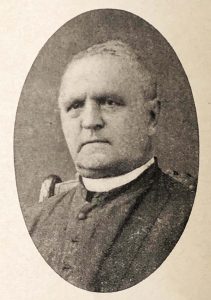
Rev. Joseph Goebbels, ca. 1870. The Panic of 1873 put an end to his two well-intentioned businesses for the parish. (Courtesy of St. Augustine Church Archives.)
St. Augustine’s congregation owes much to the appointment of Fr. Abeln, who would rise to become one of the more dominant figures in the parish’s 150-year history. Out of the chaos he brought order, out of uncertainty – hope. He worked diligently to restructure parish operations and renew the spirit of the people. He appointed new trustees to oversee the parish finances, renovated the old church and school, set up a promissory system to repay parish families who had tragically lost their savings in the early parish business failures, and he rented out the old brickyard property, originally purchased by Fr. Goebbels, to the Kentucky Central Railroad at a profit. Within a few years, parishioners were repaid and the bank debt was reduced sufficiently to allow the parish to begin a fund to build a new church.
Along the way, Fr. Abeln renewed the spiritual affairs of the people with such success that the congregation numbers began to grow. Records show that in 1877, there were 120 families registered with the parish, and by 1887, that number had grown to 175. The school likewise began to prosper: in 1883, there were 150 pupils enrolled, and within ten years that number grew to 221. The Sisters of Notre Dame, first hired in 1875 to teach at the school, were brought back under Fr. Abeln to continue their work as if they had never left.
By 1910, with many financial and pastoral successes behind him, Fr. Abeln was able to look optimistically to the future of St. Augustine parish. Now 66 years of age, he diligently began the involved process of planning for the construction of the new church. In December, he and Bishop Maes personally selected a location at the corner of Nineteenth Street and Euclid Avenue and began looking for an architect to design it and supervise its construction.
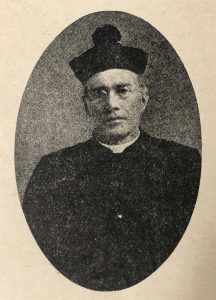
(Rev Paul T. Abeln, photo ca. 1900. An astute and capable administrator, he almost single-handedly led St. Augustine Parish from insolvency to prosperity. Courtesy of St. Augustine Church Archives.)
But one spring morning in 1911, as Fr. Abeln walked back to the priest’s house from mass, he noticed the head cold he had been nursing for weeks was not getting any better. The winter had been a mild one as winters go, and March arrived with even warmer temperatures and the promise of an early spring. Nonetheless, the head cold settled into his chest, and by month’s end, he was confined to his bed in the parish house with fever and a diagnosis of pneumonia. He knew he had done good work and was grateful to God for having been a part of the effort that rebuilt St. Augustine parish after its turbulent early years. He was also satisfied to know that at the time he fell ill, the parish was debt-free and $34,000 was available for construction of the new church.
But Fr. Abeln’s dream of seeing the new St. Augustine would never be realized. As the days of March slipped into April, he grew weaker. He knew the task he had begun would fall to his successor, whom he prayed would lead the parish into an even stronger future. On April 9, 1911, Fr. Paul Abeln died of heart failure as a complication of pneumonia. The news of his death came as a great blow to his parishioners, to whose hearts he had endeared himself during his long years of work and care for St. Augustine parish and the people of Peaselburg.
Next time…a new pastor and an architect create an unforgettable Renaissance-style work of art for the people of Peaselburg.
Stephen Enzweiler is an author and a writer of Northern Kentucky history. He is a former columnist for the Kentucky Enquirer and is the Cathedral Historian at St. Mary’s Cathedral Basilica of the Assumption in Covington.
























